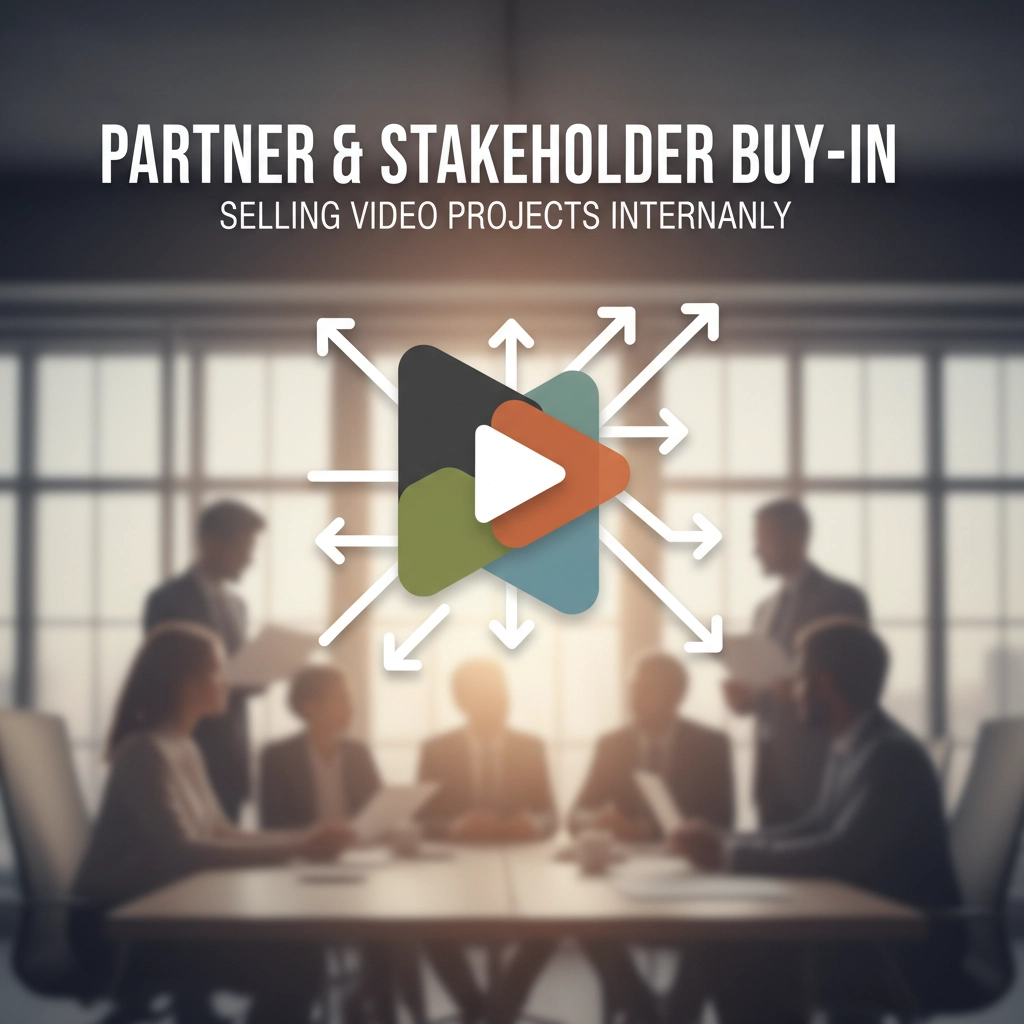Partner & Stakeholder Buy-In: Selling Video Projects Internally

Getting your team excited about a video project should be the easy part, right? Wrong. If you've ever tried pitching video production to your nonprofit's leadership team, you know that getting internal buy-in can feel like herding cats while juggling flaming torches.
Here's the thing: your board members, program directors, and fellow staff aren't trying to be difficult. They're just asking the same questions that keep them up at night: questions about budgets, impact, and whether this video thing is actually going to move the needle for your cause.
Let's talk about how to turn those skeptical head shakes into enthusiastic nods.
Know Your Internal Audience
Before you walk into that meeting with your killer video concept, take a step back. Who are you actually trying to convince, and what makes them tick?
Your Executive Director is probably thinking about overall organizational impact and how this fits into the strategic plan. They want to know: will this help us reach more people, raise more funds, or deliver our programs more effectively?
Program Directors are laser-focused on their specific initiatives. They're wondering if video will showcase their work authentically and whether it'll create more work for their already stretched teams.
Board members often come from business backgrounds and want to see clear ROI projections. They're asking tough questions about opportunity costs and measurable outcomes.
Development teams are your potential champions: they understand how compelling storytelling drives donations and grants. But they also need to know the video will actually be usable for their campaigns.

Take Toronto's Daily Bread Food Bank, for example. When they pitched their first major video campaign internally, they knew their program team was worried about disrupting client services during filming. Their solution? They presented a detailed production plan that showed exactly how they'd capture powerful stories without interfering with food distribution operations.
Build Your Business Case (Without the Business School Jargon)
Here's where most people go wrong: they lead with the creative vision instead of the practical impact. Your stakeholders don't need to fall in love with your artistic concept first. They need to understand why this matters for your mission.
Connect to Existing Pain Points
Is your website bounce rate terrible because you're explaining your complex programs with walls of text? Are donors asking for more transparency about where their money goes? Are volunteers struggling to understand their role during orientation? These are golden opportunities to position video as the solution.
Show Them the Numbers That Matter
Forget fancy industry statistics. Use data that speaks to your organization's specific challenges:
- "Our current donor newsletter has a 12% open rate, but nonprofits using video in email see 25% higher engagement"
- "It takes our program team 3 hours to explain our services to new referral partners: a 10-minute video could handle the basics"
- "We spent $8,000 on our last brochure redesign that lasted one year. This video asset can work across multiple campaigns for three years"
Present Multiple Use Cases
Don't pitch a single video: show them how one production can create multiple assets. That donor story could become a website hero video, social media content, grant application materials, and volunteer recruitment tool.
Address the Elephant in the Room: Budget Concerns
Let's be honest: nonprofits are always worried about money. And rightfully so. Every dollar spent on marketing and communications is a dollar not going directly to programs.
But here's how you reframe it: video isn't a cost, it's leverage.

Break Down the True Cost of Status Quo
How much staff time is currently spent explaining your programs to stakeholders? What's the cost of losing potential donors because they can't connect emotionally with your cause? Hamilton's Good Shepherd Centres calculated that staff were spending 15 hours per week giving facility tours. A virtual tour video reduced that to 3 hours while reaching 10 times more potential supporters.
Propose Pilot Projects
Nothing kills skepticism like proof. Start with a smaller project that demonstrates value before asking for the full campaign budget. Maybe it's a single program spotlight or a brief volunteer testimonial. Once stakeholders see the engagement numbers, the next approval gets easier.
Show the Ripple Effect
Explain how video investment pays dividends across departments. That volunteer recruitment video doesn't just help HR: it reduces onboarding costs, improves volunteer retention, and frees up program staff time.
Tackle the "We Don't Have Time" Objection
This one's tricky because, let's face it, nonprofit staff are legitimately swamped. But video production doesn't have to be a massive disruption.
Present a Clear Timeline
Show exactly what's required from internal staff and when. Be realistic about interview time, review periods, and feedback cycles. Ottawa's United Way learned this lesson when their first video project stalled because they underestimated how long board approval would take. Now they build review time into every production schedule.
Identify Your Internal Champions
You don't need everyone to be enthusiastic: you need the right people to be enthusiastic. Find staff members who are natural storytellers or comfortable on camera. Their excitement will be contagious.
Offer to Handle the Heavy Lifting
Position yourself (or your video partner) as the project manager. "You focus on your programs: we'll handle the logistics, scheduling, and coordination."

Make It Feel Less Risky
Change feels scary, especially when you're working with limited resources and high stakes. Reduce that fear by making the project feel manageable and reversible.
Share Success Stories from Similar Organizations
London's Boys and Girls Club increased their volunteer applications by 300% after launching a video series showcasing different volunteer roles. Scarborough's Centre for Integrated Healing saw a 45% increase in program referrals after creating client story videos for their website.
Build in Checkpoints
Show how the project can be paused or adjusted if things aren't working. Maybe that means reviewing rough cuts before final production or testing one video before committing to a series.
Address the "What If We Look Unprofessional" Fear
Many nonprofits worry that their video won't look polished enough compared to corporate content. Remind them that authenticity beats perfection in nonprofit storytelling. Donors want to see the real impact, not Hollywood production values.
Present Like You Mean It
When it's time for the actual pitch, your presentation style matters as much as your content.
Lead with Impact, Not Process
Start with the end result: "Imagine if potential donors could experience our programs firsthand before deciding whether to give." Then work backward to how video makes that possible.
Use Visual Examples
Don't just describe your vision: show examples from similar organizations. Create a simple mood board or reference reel that helps stakeholders visualize the end product.
Practice the "So What?" Test
For every point you make, ask yourself "so what?" If you can't answer that question clearly, your stakeholders won't be able to either.

Keep the Momentum Going
Getting initial approval is just the beginning. The real challenge is maintaining enthusiasm throughout the production process.
Involve Stakeholders in Development
Let board members suggest interview questions. Ask program directors to review storyboards. When people contribute to the creative process, they become invested in the outcome.
Share Behind-the-Scenes Updates
Send quick updates with photos from filming days or snippets of positive feedback from interview subjects. These small touchpoints keep the project visible and exciting.
Celebrate Early Wins
Did the rough cut make someone cry happy tears? Share that moment. Is the preview generating positive buzz on social media? Send screenshots to the team.
The Long Game
Remember, you're not just trying to get this video project approved: you're building credibility for future video initiatives. Approach this first project as a proof of concept that opens doors for bigger opportunities.
Track everything: engagement metrics, cost savings, staff time efficiencies, and stakeholder feedback. Document the process so next time, you can lead with concrete results instead of projections.
Most importantly, make it collaborative. When your team feels ownership over the video's success, they become your biggest advocates for the next project.
The truth is, nonprofit video projects succeed when everyone feels like they're part of telling your organization's story: not just watching someone else tell it.
Ready to turn your video vision into reality? We specialize in helping nonprofits navigate the internal buy-in process and create compelling content that drives real results. Get in touch with our team to discuss how we can support your next video project from concept to launch.
